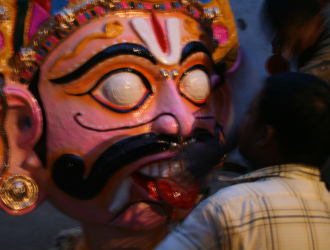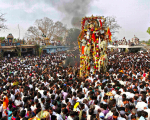Over the last six decades, the traditional Koovagam Koothandavar festival has transformed into a site for the congregation and assertion of identity for transgender people from all over India. This photo essay situates the annual Koovagam Koothandavar temple in the more extensive Bharathakoothu festivities of the northern districts of Tamil Nadu. Koothandavar, more widely known as Aravan, is the son of Arjuna and the Naga princess Ulupi. Aravan, who is sacrificed before the war, is also an eternal witness to the war and unfulfilled love and desire. The twin narratives of being the chosen and the condemned one in the Aravan mythology serves as a metaphor for the self-perception of transgender people. Over the last two decades, governments have converted the site of the festival into an advertising ground for the prevention of AIDS and advocacy for sexual hygiene. At Koovagam, while the grand epic themes of death, sacrifice, human longing and sexual identity collide with mythology, history, and the autobiographies of the transgender people, it continues to remain as a site of conflict, media sensationalism, transgender advocacy and a liminal space of desires.





Bharathakoothu VII: Aravan and the Transgender Community
in Image Gallery
Published on:

M.D. Muthukumaraswamy
M.D. Muthukumaraswamy is a Tamil writer, Director of National Folklore Support Centre and a Consultant at Sahapedia.











